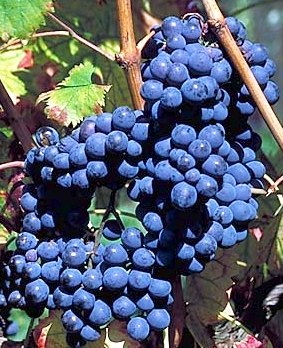
Sangiovese Grapes
Chianti
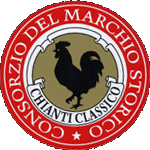
Chianti Classico
Black Rooster
 Sangiovese Grapes |
Chianti |
 Chianti Classico Black Rooster |
A Tuscany Delight |
||
| On
the eastern coast in the
heart of Italy lies the marvelous wine growing region of Toscana, home
of the extraordinary Sangiovese based wines of Chianti, Brunello di
Montalcino, Vino Nobile di Montepulciano and some of the best value
wines available. Outside of the Piemonte region in NE Italy which is
home to the renowned Nebbiolo based Barolo and Barbaresco, Tuscany is
the most famous wine region in Italy. The area is huge with over 157,000 acres (63,633 hectares) under production and yielding 57 million gallons of wine. Wines of Italy account for 60% of U.S.A. wine imports. When I find out how much of that comes from Chianti, I will alter this paragraph and report it here. I have another statistic that will probably fit here. Annual wine consumption per capita in Italy is about 26 gallons per person compared with 2 gallons per person in the U.S.A. Chianti, with over 5,000 vintners, has been divided into two appellations: Chianti Classico and Chianti, which consists of seven subzones. The subzones, clustered around the Classico zone, are: Colli Aretini, Colli Fiorentini, Colli Senesi, Colline Pisane, Montalbano, Rufina and Montespertoli. (By the way, Chianti Classico refers to a defined area, zone or appellation only and does not imply or suggest a superior growth or bottling method.) |
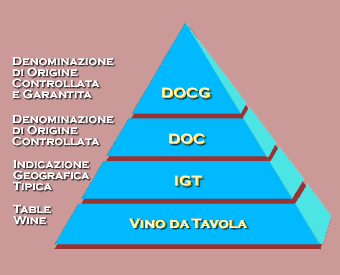
| All
appellations within Chianti fall into the DOCG classification.
(Denominazione di Origine Controllata e Garantita) (Name of Origin
Certified and Guaranteed) DOCG wines, first classified in 1980 with the
intention of adding a quality classification to the top of the wine
pyramid,began with five wines. Chianti, Brunello di Montalcino, Vino
Nobile di Montepulciano, all from Tuscany, and Barolo and Barbaresco,
both produced in Piedmont. All five had solidly established
international reputations and all but one, Brunello (developed since
the middle of the 19th century), had been produced for centuries in one
form or another. The selection of the five for elevation to the peak of
the Italian wine pyramid was, therefore, a foregone conclusion. When I
authored this page in 2004 a total of 24 wines had been awarded the
prestigious DOCG status. Today, the list includes a total of 73 wines
have been awarded the prestigious DOCG status. The List A DOCG wine must meet standards that are stricter than those stipulated in DOC regulations. One of the principal differences is the lower yields imposed by the DOCG rules. The reductions in output have probably done more to boost the quality of the wines than any other provision in the production codes. The rules also require in-depth chemical analysis for all DOCG wines. Laboratories recognized by the government must carry out the examinations of the wines' physical composition. Once the analyzes have demonstrated that the chemical properties are in accordance with the standards specified in the DOCG regulations, committees consisting of expert tasters sample each producer's wines. The committees can reject wines that fail to meet the specified sensory standards or instruct the producers to take steps to remedy deficiencies before approving or discarding the product. Upon receipt of a favorable report on the outcome of the chemical and sensory analyzes, the producers' consortia or, some other official body issues small pink numbered seals that fit over the corks in the bottles of DOCG wines. Strict controls are applied to ensure that the number of seals issued corresponds to the amount of wine that can be produced in accordance with the limitations of the regulations. Additional wines are petitioning for DOCG classification, so the existing group of 24 will continue to grow. A DOCG wine must meet standards that are stricter than those stipulated in DOC regulations. One of the principal differences is the lower yields imposed by the DOCG rules. The reductions in output have probably done more to boost the quality of the wines than any other provision in the production codes. The rules also require in-depth chemical analysis for all DOCG wines. Laboratories recognized by the government must carry out the examinations of the wines' physical composition. Once the analyzes have demonstrated that the chemical properties are in accordance with the standards specified in the DOCG regulations, committees consisting of expert tasters sample each producer's wines. The committees can reject wines that fail to meet the specified sensory standards or instruct the producers to take steps to remedy deficiencies before approving or discarding the product. Upon receipt of a favorable report on the outcome of the chemical and sensory analyzes, the producers' consortia or, some other official body issues small pink numbered seals that fit over the corks in the bottles of DOCG wines. Strict controls are applied to ensure that the number of seals issued corresponds to the amount of wine that can be produced in accordance with the limitations of the regulations. Additional wines are petitioning for DOCG classification, so the existing group of 24 will continue to grow. Chianti is a blended wine made from four grape varieties. They are sangiovese, canaiolo, and two grapes which are used mainly for white wines, trebbiano, and malvasia. Recently, cabernet sauvignon is being added to some Chianti blends. More about that later. Chianti, depending upon where the grape is grown and the vintage, ranges from a light and fruity wine all the way to a full bodied, dry, tannic and acidic wine that will age for 10 years or more. The Chianti production code requires a minimum of 75% of the sangiovese grape be used. (80% for the Classico appellation) The code allows up to three other varieties to be used. Red Canaiolo (up to 10%) and white Malvasia and/or Trebbiano (up to 6% each). Beginning with the Classico appellation harvest in 2005, the white grape varietals are eliminated. Click here to read the Chianti Classico DOCG Production Code. The Chianti production code also imposes strict limitations on production. A maximum of 6.6 pounds (3 kilos) of grapes per vine, and 16,500 pounds (30.36 Quintals) per acre, and 559 gallons per acre. Minimum alcohol requirements are12% for Chianti and 12.5% for Riserva. Ageing requirements are 12 months for Chianti and 24 months for Chianti Riserva. |
Italy Wine Regions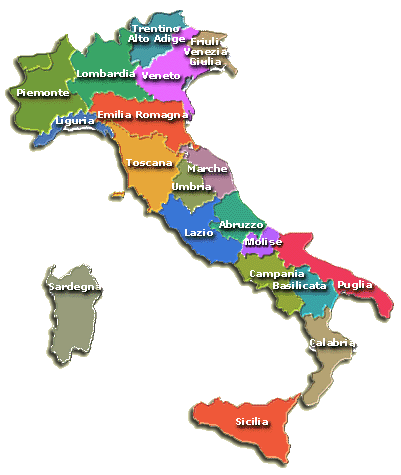 |
Chianti Appellations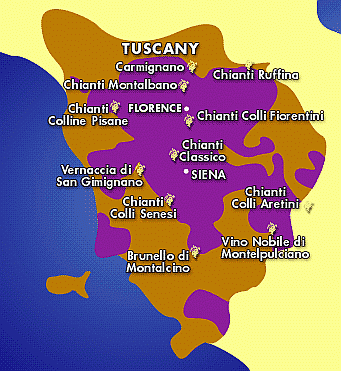 |
| The famous
Black Rooster - Chianti Classico area wines can be part of the
"Consorzio del Marchio Storico-Chianti Classico", whose primary purpose
is to verify the quality of the wine and promote it. It was founded in
1924 by 33 producers meeting at Radda in Chianti. The wines that are
part of the Consortium have their bottles marked by the Consortium's
seal of guarantee depicting a Black Rooster circled by red if they are
Chianti Classico or circled by gold if they are Chianti Classico
Riserva. The word "Riserva" on the label can be used for only DOC or DOCG wines and it indicates the wine is of superior quality and has been aged for at least 3 years before being released. For your information, Barbaresco Riserva is aged for 4 years and Barolo and Brunello receive 5 years of ageing. The words "Vino da Tavola" on the label is an enigma. The name implies an everyday, simple and inexpensive table wine where you will find your "value" or "bargain" wines. The wines typically come from grapes that are inferior and do not qualify for official recognition or they could be from appellations outside of Chianti. However, the wines could come from the excellent grapes of DOCG growers whose excess production is not permitted to be sold under their own Chianti label. Italy has 1.2 million growers. Famous DOCG vintners frequently purchase grapes from these growers and utilize their excess production capacity to bottle table wines. There are no regulations for Vino da Tavola except, of course, for the normal health and safety rules applied to all wines. Ironically, Vino da Tavola also applies to the new "Super Tuscan" wines. Some of these "ST" wines can fetch $100 - $200 on your wine merchants shelves. ST wines began over 30 years ago when vintners wanted to try new blends with their sangiovese grapes but were prevented from doing so by the highly restrictive classification codes. Adding other red grapes such as Cabernet Sauvignon, Merlot and Cabernet Franc, which were then illegal, and deleting the white grapes of Malvasia and Trebbiano added greatly to the body and flavors of the new wines but they violated the then DOC rules and the vintners were not allowed to display the DOC, or even the IGT, classifications on their labels. Over the years, these ST wines have gained a significant following of loyal customers who routinely pass over a $20 DOCG wine and purchase a $60 bottle of Vino da Tavola. |
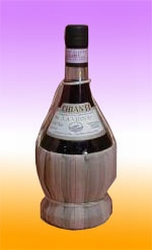 |
Here's a fun little piece of information. Do you remember the straw covered bottle we always associated with cheap Chianti wines? That bottle is called a Fiasco. (fee YASS co) The Italian word for flask. The straw protected the thin glass in the bottle and kept it from tipping over. Fiaschi are hard to find these days because of the prohibitive labor cost of hand wrapping each flask to store a cheap wine, and the higher quality more expensive wines with aging potential need bottles that can be laid on their sides. |
| Here is another fun piece of trivia
information. We are all aware that Brunello di Montalcino, the highly
desirable Sangiovese Grosso based wine, is named in honor of the
village of Montalcino located in the SW area of Tuscany. Additionally,
Vino Nobile di Montepulciano, another highly desirable Sangiovese based
wine, is named in honor of the village of Montepulciano located in the
SE area of Tuscany. However, the very popular Montepulciano wine, is
based on the Montepulciano grape and is not named after the Tuscany
village but after the Montepulciano grape which is grown in the region
of Abruzzo (see the maps above) located East and South of Tuscany and
is a personal favorite wine of mine, Montepulciano d'Abruzzi DOC and
Montepulciano d'Abruzzo Colline Teramane DOCG. Both excellent choices.
You may want to read this paragraph twice. I wrote it and it confuses
me. Men are like grapes. Women
have to stomp the poop out of them
until they mature into something worth having for dinner. |
Pronunciation / Terminology Guide |
|
| Bianco |
Bee ON
co - White |
| Brunello
di Montalcino |
Brew NELL
Oh Dee Mon Tall CHEE
No |
| Canaiola |
Caw
nah YAW loh - and -
kah-nay-YOH-loh (red wine grape) |
| Carmignano |
Car me
NAH no |
| Chianti |
Key AWN tee |
| Denominazione
di Origine Controlata e Garantita - (DOC) (DOCG) |
Day
Nom E Nah Zee ON
Nay - Dee Oh Ree GEE Nay - Con Troll OTT Ta - Gar ran TEE Ta (Name of Origin Certified (Controlled) and Guaranteed) |
| Dolcetto |
Dole CHET oh |
| Fiasco |
Fee YASS co (Flask-squat
straw covered bottle) |
| Gattinara |
Gah
Tee NAH rah |
| Indicazione
Geografica Tipica |
help me
please |
| Malvasia |
Mall
vah SEE ah (white
wine grape) |
| Montalcino | Mawn
tall CHEE no |
| Montepulciano |
Mawn
teh pool CHAH no |
| Nebbiolo |
Nay Be-OH Low |
| Piedmont
(Piemonte) |
PEED-Mont or (Pay-MAWN-tay) |
| Riserva |
ree ZEHR vah |
| Rosso |
RO-So - Red |
| Sangiovese |
San
Jaw VAY Seh - or -
San Joe VAY Seh (red wine grape-Chianti) |
| Trebbiano
(France-Ugni Blanc) |
Treb e AH no (OO nee blanc) (white
wine grape) (used in brandy) |
| Tuscany |
TUS kuh nee (large Italy
growing region) |
| Vino da
Tavola |
Tuh VOH La - Wine of
the Table - Table Wine (also applies to Super Tuscan) |
| Vino
Nobile di Montepulciano |
VEE no NAW be lay dee mawn teh pool CHAH no |
Nation Visitors Since March 8, 2013